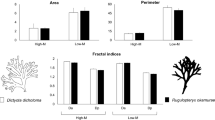Abstract
Species traits which facilitate introduction and predominance have been quantitatively ranked using interval arithmetic to search for common patterns among 113 marine macroalgae introduced in Europe. Three main categories were used: dispersal, establishment and ecological impact. These were further subdivided into more specific categories, a total of 13. Introduced species were compared with the same number of native species randomized from the same families as the introduced. Invasive species (i.e. species having a negative ecological or economical impact) were also compared with non-invasive introductions, separately for the three algal groups. In many categories, as well as when adding all species, the introduced species ranked more hazardous than the native species and the invasive species ranked higher than the non-invasive ones. The ranking within the three main categories differed, reflecting different strategies between the species within the three algal groups. When all categories (excluding salinity and temperature) were summed, the top five risk species, all invasive, were, in descending order, Codium fragile spp.tomentosoides, Caulerpa taxifolia, Undaria pinnatifida, Asparagopsis armata and Grateloupia doryphora, while Sargassum muticum ranked eight and Caulerpa racemosa ten. Fifteen of the twenty-six species listed as invasive were among the twenty highest ranked.
Similar content being viewed by others
References
Anonymous (2000) European Register of Marine Species. Algae full detailed checklist. http://erms.biol.soton.ac.uk/ [21-02-03].
N Bax JT Carlton A Mathews-Amos RL Haedrich FG Howarth JE Purcell A Rieser A Gray (2001) ArticleTitleThe control of biological invasions in the world’s oceans Conservation Biology 15 1234–1246
CF Boudouresque M Verlaque (2002) ArticleTitleBiological pollution in the Mediterranean Sea: invasive versus introduced macrophytes Marine Pollution Bulletin 44 32–38 Occurrence Handle11883681 Occurrence Handle1:CAS:528:DC%2BD38XmsVyruw%3D%3D
AM Breeman EJS Meulenhoff MD Guiry (1988) ArticleTitleLife history regulation and phenology of the red alga Bonnemaisonia hamifera Helgoländer Meeresuntersuchungen 42 535–551
K Clay (2003) ArticleTitleParasites lost Nature 421 585–586 Occurrence Handle12571575 Occurrence Handle1:CAS:528:DC%2BD3sXovFKhsw%3D%3D
AT Critchley WF Farnham SL Morrell (1986) ArticleTitleAn account of the attempted control of an introduced marine alga, Sargassum muticum, in southern England Biological Conservation 35 313–332
WF Farnham (1997) Espèces invasives sur les côtes de la Manche et de l’Atlantique. In: Dynamique d’Espèces Marines Invasives: Application à l’Expansion de Caulerpa taxifolia en Méditerranée Académie des Sciences Paris 15–35
B Gavio S Fredrique (2002) ArticleTitleGrateloupia turuturu (Halymeniaceae, Rhodophyta) is the correct name of the non-native species in the Atlantic known as Grateloupia doryphora European Journal of Phycology 37 349–359
MD Guiry CJ Dawes (1992) ArticleTitleDaylength, temperature and nutrient control of tetrasporogenesis in Asparagopsis armata (Rhodophyta) Journal of Experimental Marine Biology and Ecology 158 197–217
MD Guiry E Nic Dhonncha (2003) AlgaeBase version 2.0. World-wide electronic publication National University of Ireland Galaway
KR Hayes FR McEnnulty C Sliwa (2003) Ranking potential next pests. Third International Conference on Marine Bioinvasions, Abstract Book, p. 57 Scripps Institution of Oceanography La Jolla, CA
CS Kolar DM Lodge (2001) ArticleTitleProgress in invasion biology: predicting invaders Trends in Ecology and Evolution 16 199–204 Occurrence Handle11245943
K Lüning (1990) Seaweeds: their Environment, Biogeography, and Ecophysiology John Wiley & Sons, Inc. New York 527
CA Maggs H Stegenga (1999) ArticleTitleRed algal exotics on North Sea coasts Helgoländer Meeresuntersuchungen 52 243–258 Occurrence Handle10.1007/BF02908900
D Minchin S Gollasch (2002) Vectors–how exotics get around E Leppäkoski S Gollasch S Olenin (Eds) Invasive Aquatic Species of Europe. Distribution, Impact and Management Kluwer Academic Publishers Dordrecht, The Netherlands 183–192
CE Mitchell AG Power (2003) ArticleTitleRelease of invasive plants from fungal and viral pathogens Nature 421 625–627 Occurrence Handle10.1038/nature01317 Occurrence Handle1:CAS:528:DC%2BD3sXovFKnsQ%3D%3D Occurrence Handle12571594
A Prinzing W Durka S Klotz R Brandl (2002) ArticleTitleWhich species become aliens Evolutionary Ecology Research 4 385–405
MA Ribera Siguan (2002) Review of non-native marine plants in the Mediterranean Sea E Leppäkoski S Gollasch S Olenin (Eds) Invasive Aquatic Species of Europe. Distribution, Impact and Management Kluwer Academic Publishers Dordrecht, The Netherlands 291–310
AK Sakai FW Allendorf JS Holt DM Lodge J Molofsky KA With S Baughman RJ Cabin JE Cohen NC Ellstrand DE McCauley P O’Neil IM Parker JN Thompson SG Weller (2001) ArticleTitleThe population biology of invasive species Annual Review of Ecology and Systematics 32 305–332
CA Squair JE Smith CL Hunter CM Smith (2003) An introduction to invasive alien algae in Hawaii: ecological and economic impact. Third International Conference on Marine Bioinvasions, Abstract Book Scripps Institution of Oceanography La Jolla, California 115
ME Torchin KD Lafferty AP Dobson VJ McKenzie AM Kuris (2003) ArticleTitleIntroduced species and their missing parasites Nature 421 628–630 Occurrence Handle10.1038/nature01346 Occurrence Handle1:CAS:528:DC%2BD3sXovFKntA%3D%3D Occurrence Handle12571595
I Wallentinus (2002) Introduced marine algae and vascular plants in European aquatic environments E Leppäkoski S Gollasch S Olenin (Eds) Invasive Aquatic Species of Europe. Distribution, Impact and Management Kluwer Academic Publishers Dordrecht, The Netherlands 27–52
MH Williamson A Fitter (1996) ArticleTitleThe characters of successful invaders Biological Conservation 78 163–170
www.aqualiens.tmbl.gu.se.
Author information
Authors and Affiliations
Corresponding author
Rights and permissions
About this article
Cite this article
Nyberg, C.D., Wallentinus, I. Can species traits be used to predict marine macroalgal introductions?. Biol Invasions 7, 265–279 (2005). https://doi.org/10.1007/s10530-004-0738-z
Received:
Accepted:
Issue Date:
DOI: https://doi.org/10.1007/s10530-004-0738-z




